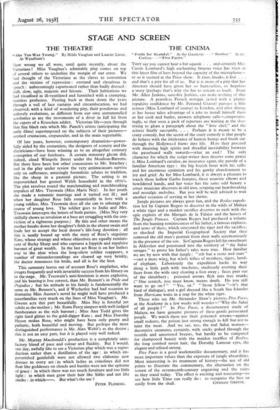THE CINEMA
"Fools for Scandal." At the Gaumont ----" Booloo." At di: Carlton--" Five Faces."
THEY say you cannot hear a bat squeak . . . and certainly Miss Carole Lombard's high enchanting fatuous voice has risen in this latest film of hers beyond the capacity of the microphone— or so it seemed at the Press show. It rises, breaks, is lost . . . and that's a pity for all of us. But it is more of a pity that her directors should have given her so humourless, so hopeless a 'story (perhaps that's why she has to scream so loud). Even Mr. Allen Jenkins, sure-fire Jenkins, can make nothing of this picture. A penniless French marquis (acted with a plump repulsive confidence by Mr. Fernand Gravet) pursues a film actress (Miss Lombard of course) to London, and after dining at her house takes advantage of a joke to install himself there as her cook and butler, answers telephone calls—zompromis- ingly, so that soon a pack of reporters are waiting at the door trying to glean a paragraph about the " love chef," and the actress finally succumbs. . . . Perhaps it is meant to be a crazy comedy, but the secret of the crazy comedy is that people do behave with the irrelevance of human beings and break out through the Hollywood frame into life. Here they proceed with daunting high spirits and dreadful inevitability between the pasteboard walls towards—what an end ! The only character for which the script-writer does deserve some praise is Miss Lombard's cavalier, an insurance agent, the parody of a familiar American type : the big boyish lover with his sulks and his enormous optimism and his gawky abandonment to joy and grief. As for Miss Lombard, it is always a pleasure to watch those hollow Garbo features, those neurotic elbows and bewildered hands, and her voice has the same odd beauty a street musician discovers in old iron, scraping out heartbreaking and nostalgic melodies. But you will be well advised to wait another occasion of serving at her shrine.
Jungle pictures are always great fun, and the Booloo expedi- tion led by Captain Rogers to discover in the wilds of Malaya a white tiger and a maiden sacrifice deserves to rank with the epic exploits of the Marquis de la Falaise and the heroes of The Jungle Princess. Captain Rogers had produced a volume from the hunting reminiscences of his father, a famous explorer, and some of these, which concerned the tiger and the sacrifice, so shocked the Imperial Geographical Society that they removed the old man's portrait from their walls ceremoniously in the presence of the son. So Captain Rogers left his sweetheart in Aldershot and penetrated into the territory of " the Sakai savages " to prove his father's tales were true. How familiar we are by now with that jungle : "stir but a stone and start " —not a mere wing, but whole tribes of monkeys, tigers, herdi of elephant. Laboriously the expedition hacks its way along a little path with machetes, studiously averting their faces from the wide easy clearing a foot away ; faces peer out of the shrubbery ; poisoned arrows flick into tree trunks (" One scratch, you must know, means death. Do you still want to go on ? " " Yes, sir." " Stout fellow "—it's that kind of dialogue), and a girl dressed like a South Sea Islander from Hurricane waits in a trap for the white tiger.
Those who see Mr. Alexander Shaw's picture, Five Faces, at the Academy in a few weeks will wonder—" Why the Sakai of all people ? " In Five Faces, a documentary study of Malaya, we have genuine pictures of these gentle persecuted people. We watch them use their poisoned arrows—against small rodents, the poison just strong enough to kill but not to taint the meat. And we see, too, the real Sakai women— decorative creatures, certainly, with sticks poked through the nostrils and uncovered breasts, but hardly to be compared for shampooed beauty with the maiden sacrifice of Booloo, the long combed raven hair, the Dorothy Lamour eyes, the elegant and refined sarong.
Five Faces is a good workmanlike documentary, and it has
more important values than the exposure of jungle absurdities. Most interesting is its treatment of history—the use of old prints to illustrate the commentary, the alternation on the screen of the seventeenth-century engraving and the ruins as they stand today. The effect is exciting and reassuring—to see how little Time can really do : to recognise the face so


































 Previous page
Previous page